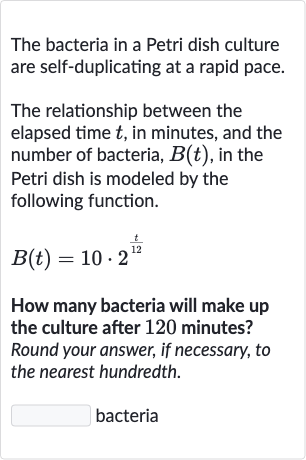AI tutor
Welcome to Bytelearn!
Let’s check out your problem:

The bacteria in a Petri dish culture are self-duplicating at a rapid pace.The relationship between the elapsed time , in minutes, and the number of bacteria, , in the Petri dish is modeled by the following function.How many bacteria will make up the culture after minutes?Round your answer, if necessary, to the nearest hundredth.bacteria
Full solution
Q. The bacteria in a Petri dish culture are self-duplicating at a rapid pace.The relationship between the elapsed time , in minutes, and the number of bacteria, , in the Petri dish is modeled by the following function.How many bacteria will make up the culture after minutes?Round your answer, if necessary, to the nearest hundredth.bacteria
- Identify function: Identify the given function that models the number of bacteria over time.The function is .
- Substitute time: Substitute the given time minutes into the function to find ..
- Simplify exponent: Simplify the exponent by dividing by ..
- Calculate power: Calculate raised to the power of ..
- Multiply result: Multiply the result from Step by to find the number of bacteria after minutes..
- Perform multiplication: Perform the multiplication to get the final result. .
More problems from Weighted averages: word problems
QuestionGet tutor help
QuestionGet tutor help
QuestionGet tutor help
QuestionGet tutor help
QuestionGet tutor help
QuestionGet tutor help
QuestionGet tutor help
QuestionGet tutor help
QuestionGet tutor help
